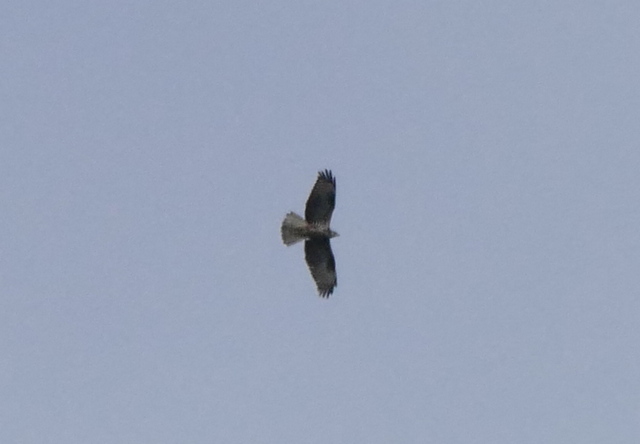Day 3, the final day, of a long weekend of tours today. We met earlier than normal as we had to finish slightly earlier than we might do otherwise, due to a prior commitment. Still we had an excellent day’s birding – and a sweet surprise to boot.
It was originally forecast to be dry today, but in the last 24 hours that had changed to be wet early in the morning. And so it proved to be – just for once the forecast was unfortunately not wrong. Still, the rain was light and mercifully brief and it didn’t make much difference to us. Given the conditions, rather than head up to the Heath first thing, we started at Cley instead. There was some light rain as we walked out to the hides, but thankfully that was about it.
There are lots of waders on the move at the moment. To us, it is still summer, but many birds are already on their way back south at the end of the breeding season. The scrapes at Cley are always a good place to look and there was a good variety on view today.
The only problem was the Avocets. When they have young, they are fiercely protective and there was a half-grown juvenile Avocet at the front of Pat’s Pool today. The adults proceeded to chase anything away that tried to land there. While chasing off Marsh Harriers is understandable, dabbling ducks, small waders and even Pied Wagtails are hardly a threat to them. Still, the adult set off after all of them and saw them off!
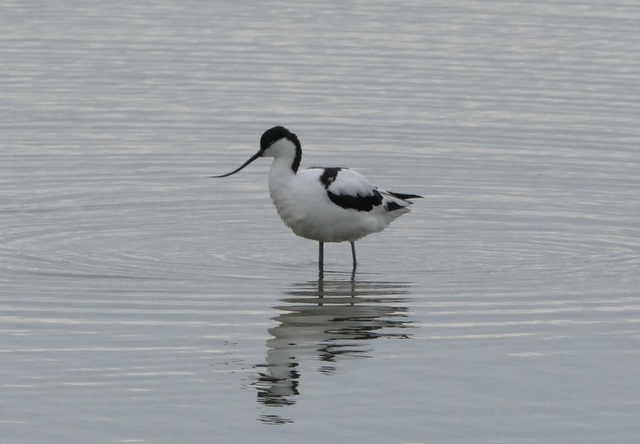 Avocet – the adults were trying to chase off any birds around the scrapes today
Avocet – the adults were trying to chase off any birds around the scrapes today
A Common Sandpiper was trying to feed around the edge of the scrape. It tried to bob its way along the front of the nearest island, but was chased off. It then tried the near bank of the scrape instead, but that was no better. In the end it flew off slightly further over, onto the mud.
 Common Sandpiper – note the white spur between the grey breast and wings
Common Sandpiper – note the white spur between the grey breast and wings
A Green Sandpiper had been feeding quietly on the island at the front of Simmond’s Scrape, but when a second bird flew in the two of them attempted to land together at the front of Pat’s Pool. Once again, the Avocet set off after them and saw them off too. Eventually, by stealth, one of the Green Sandpipers and the Common Sandpiper crept back in along the front edge of the near island. It was great to see them up close and get a chance to look at the differences between them.
 Green Sandpiper – darker above and lacks the white spur behind the breast
Green Sandpiper – darker above and lacks the white spur behind the breast
A lone Whimbrel was out on Simmond’s Scrape. It was bathing and preening and when finished, started to jump around in a mad dance with its wings outstretched. Perhaps it was just trying to get dry? Anyway, eventually it finished what it was doing and flew off on its way west. There were also lots of Black-tailed Godwits in the scrapes as usual, with an increasing number of bright summer plumaged birds, presumably returning adults.
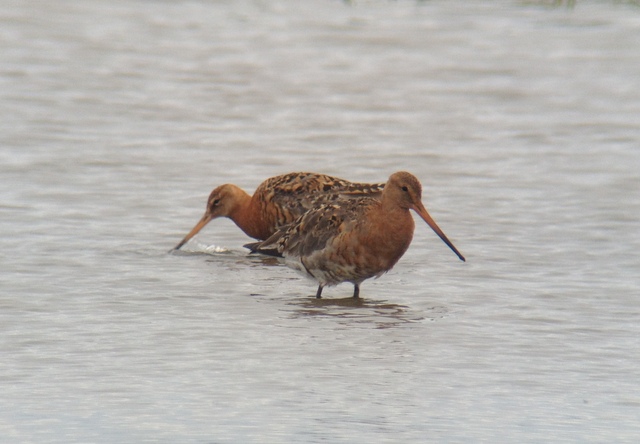 Black-tailed Godwits – a couple of the more brightly coloured individuals
Black-tailed Godwits – a couple of the more brightly coloured individuals
There were not so many smaller waders on view today. A couple of summer plumaged Dunlin were feeding on Pat’s Pool, sporting their distinctive black bellies. Another four flew in and landed on Simmond’s Scrape. There were also still several Little Ringed Plovers on the islands. Good numbers of moulting Ruff have been present in recent days along the coast and today was no exception. With a bewildering variation of plumage, particularly amongst the now moulting males, Ruff is one of the most confusing wader species for the uninitiated. A single Greenshank also flew in and landed at the back of the scrape.
There have been small numbers of Little Gulls along the coast for some time, mostly 1st summer birds. There were still five at Cley on Pat’s Pool today. They were further over than they have been – perhaps due to the overzealous parent Avocet again – but they were easy to pick out amongst the Black-headed Gull due to their much smaller size. The difference in feeding behaviour was also noticeable, with the Black-headed Gulls mostly asleep or preening, whereas the Little Gulls were actively feeding, walking around on the mud, picking for insects on the surface.
There is lots of Marsh Harrier activity around the reserve at the moment, with young birds on the wing now as well as the adults. Needless to say, the Avocets were doing their best to see them off whenever they drifted in the direction of the scrapes.
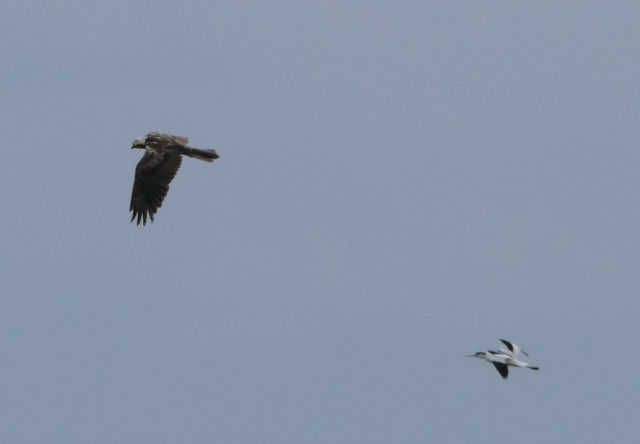 Marsh Harrier – being seen off by one of the local Avocets
Marsh Harrier – being seen off by one of the local Avocets
The highlight behaviour-wise on the reserve this morning had to be the Spoonbills. There were none on view when we first arrived, but before long the first four flew in. Amongst them was a single juvenile. Variously known as ‘teaspoonbills’ or ‘little beggars’, this one was definitely living up to the latter nickname. As soon as it landed, it set off after one of the adult Spoonbills. Even through it was fed almost immediately by its parent, it continued to chase the adult bird all over the scrape, bowing its head constantly as it did so. The poor parent tried feeding it again, but still got no peace. This went on for a long time, before the youngster finally lost interest and the adult stood preening.
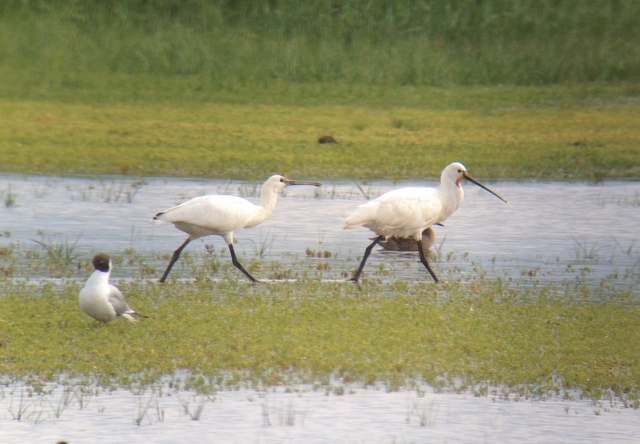 Spoonbills – this juvenile pursued its parent relentlessly to be fed…
Spoonbills – this juvenile pursued its parent relentlessly to be fed…
 …and even after being fed, it still wanted more
…and even after being fed, it still wanted more
Whilst it is always interesting to see the adults being pursued by their young, there was more action to see this morning. A little later, another three Spoonbills flew in to Simmond’s Scrape. When we looked back, we could see two of them preening each others necks. As a Spoonbill, it must obviously be hard to preen your own head and neck with a bill like that. Whether this was just a public service or part of pair bonding was not clear. Interestingly, while one of the two Spoonbills was an adult, the other was an immature (2nd calendar year bird) with retained black tips to its primaries, a thinner head and neck and a more extensive and diffuse yellow bill tip.
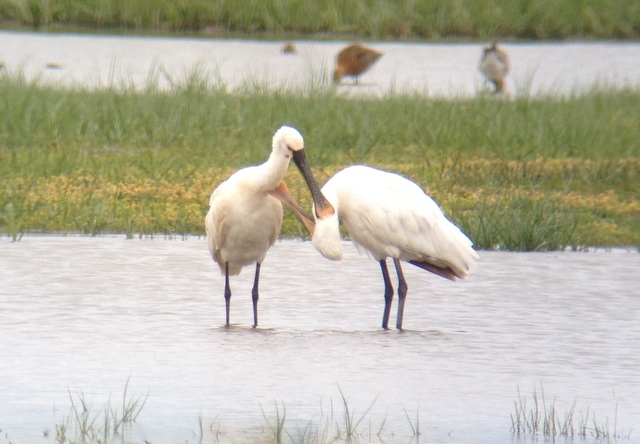 Spoonbills – these two birds were mutual neck preening
Spoonbills – these two birds were mutual neck preening
As well as the waders, there are also an increasing number of ducks returning to the scrapes, though the odd bird may have over-summered. There are many more Teal now than there were a month ago and we even found a single Wigeon out there today. A female Shoveler was in the ditch in front of the hide.
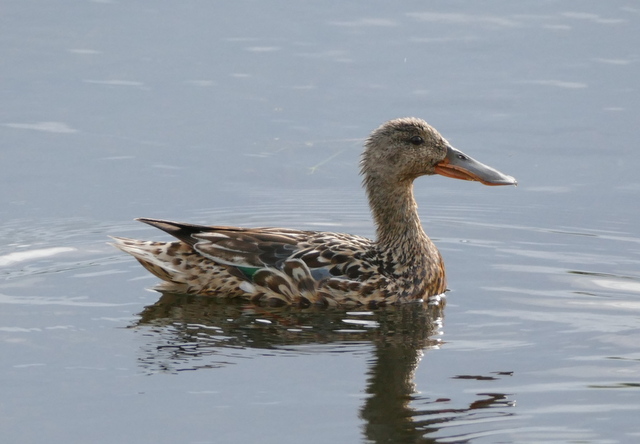 Shoveler – in the ditch right in front of the hide
Shoveler – in the ditch right in front of the hide
It was still overcast and cool by this stage, not ideal for the Heath but perfect conditions for North Scrape (reduced heat haze and not looking into the sun). We drove round to the beach car park and walked out to the site of the former North Hide – now of just a very rudimentary viewing screen. On the way, there were lots of Meadow Pipits, Reed Buntings, Linnets and Goldfinches in amongst the thistles and weedy vegetation on the shingles.
Unfortunately there was no sign here of the Little Stints which had been around the reserve yesterday. However, we did see several more Green Sandpipers – at least four. Out on the back of the scrape was a single adult Yellow-legged Gull. As well as the obviously leg colour, its dark grey mantle gave it away – not dark enough for Lesser Black-backed and obviously darker than Herring Gull. In the reeds along the side of the scrape, we also spotted at least three juvenile Bearded Tits. They were chasing each other round and perching up nicely in the open where we could see them.
By now it was at least starting to brighten up a little, so we drove up to the Heath. It was still perhaps a little cool and breezy, but we thought we were in with a chance of finding a Dartford Warbler. Little did we know what was about to fly over! As we walked up over the Heath, we could hear Yellowhammers singing and several Linnets flew up from the gorse. We looked up just in time to see a Red Kite drifting over, heading west along the ridge where the land dropped away along the coast. At this point we had a short discussion about how the Holt-Cromer ridge is a good place to look for raptors and other soaring birds, as they often like to move along the higher ground rather than along the coast.
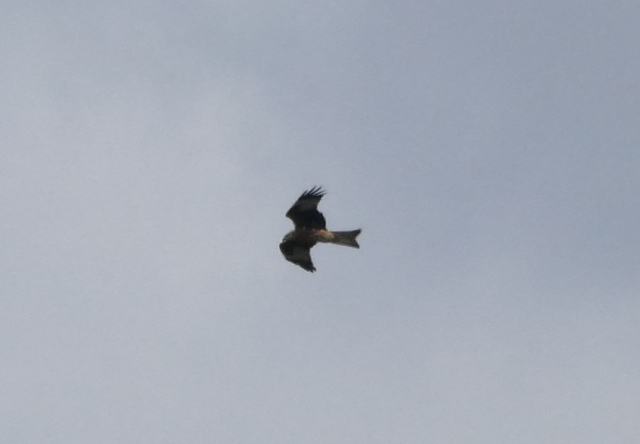 Red Kite – soared west along the ridge behind the coast
Red Kite – soared west along the ridge behind the coast
We did not get much further before we heard a Dartford Warbler singing. It was in a very thick block of gorse at first, but we were able to follow the song as it moved. It was keeping down in cover, probably due to the wind. Eventually, after following it for a couple of minutes, we got several quick flight views as it flew between bushes. We could also hear a second bird calling nearby.
We were standing waiting for the Dartford Warbler to sing again when we looked up and saw another raptor hanging in the air over the ridge. Expecting it to be one of the local Common Buzzards, we had a quick look at it through binoculars and got a surprise – it was a Honey Buzzard. The whole group got onto it and we watched it for several minutes, circling and drifting into the breeze. A sweet surprise indeed!
We could see the distinctive Honey Buzzard flight action, with wings held flat or downcurved, and the tips flexing down as it turned. The shape as well stood out – quite long-tailed and with a small head protruding cuckoo-like in front of the wings. Even from a distance, it was a noticeably pale bird, as it banked and caught the light. Eventually, it drifted to the north west and disappeared over the crest of the ridge. These are rare birds indeed in Norfolk, and it was a real treat to come across one like this.
Elated by our find, we set off to walk across to the other side of Heath. A Turtle Dove flew round in front of us and disappeared over the trees. But the Heath itself was a little quiet in the wind. We thought it might be difficult to get a better view of a Dartford Warbler than we had already had today, but walking along a favoured path we heard a Dartford Warbler call ahead of us. We repositioned ourselves for a better view and first one then a second bird flew out of the gorse in front of us. One of them perched up very nicely on the top of the gorse for several seconds so we could get a good look at it, before the two of them flew off further. We walked on round to where we had seen them drop in, but by now they had gone completely quiet. Still, it was a real result to see them so well.
By now, the Heath was starting to get much busier, more disturbed, with dog walkers and cyclists in particular. We walked back round, but all we found were more Linnets and Yellowhammers. However, we did come across a Grayling basking on the path ahead of us. It was extremely well camouflaged and hard to see until it flew.
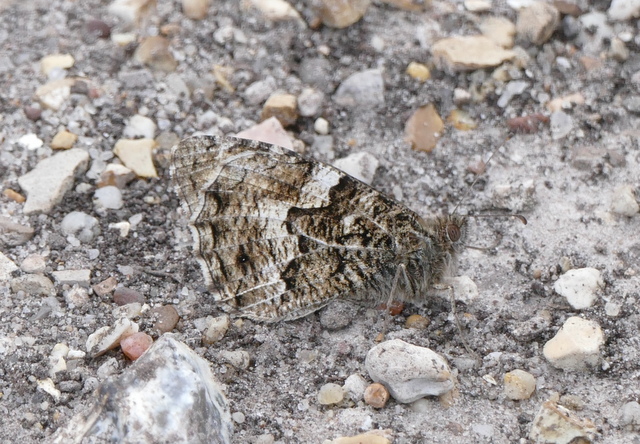 Grayling – very well camouflaged against the stony path
Grayling – very well camouflaged against the stony path
We decided to move on and drove down to Cley for a late lunch. Afterwards, we headed out for a walk down the East Bank. By now it was very windy, gusting to 35+ mph. Not surprisingly, there was no sign of Bearded Tits here today, though thankfully we had had good views of several already other the weekend. However, the grazing marshes and Serpentine were also surprisingly quiet, not even the usual roosting Black-tailed Godwits – either the birds had just been flushed off here, or perhaps they had flown off to seek somewhere more sheltered from the wind.
There was more activity out at Arnold’s Marsh. There were lots of Sandwich Terns gathered out on the islands and sandbanks, and in amongst them we could see a good number of juveniles. The big colony of Sandwich Terns is out on Blakeney Point, but once the young can fly they are often led down to somewhere like Arnold’s Marsh and left there while the adults go out to see to fish. There were also a small number of smaller, orange-red billed Common Terns in amongst them.
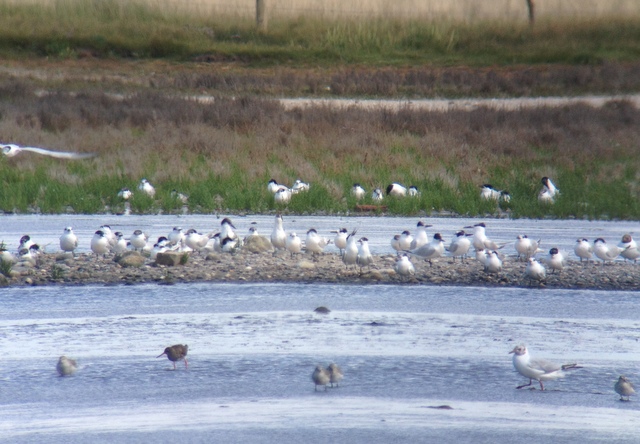 Terns – mostly Sandwich Terns gathering on one of the islands
Terns – mostly Sandwich Terns gathering on one of the islands
Out on the water, we could also see a big flock of waders. Getting them in the scope, we could see that most of them were Knot, at least 180 in total. The majority were in grey winter plumage, but amongst them we could still see a smaller number of brighter birds with orange underparts, still in summer plumage. There were also 45+ Dunlin, all adult birds with striking square black belly patches still. A careful scan revealed a handful of Bar-tailed Godwits as well – in winter type plumage, we talked about the key differences to separate them from Black-tailed Godwit. There were also plenty of Redshank, a very smart summer plumaged Turnstone and a Curlew.
With the wind having picked up so much since this morning, we walked out to the beach to see if anything was passing by offshore. The sea was certainly more choppy than it had been earlier, but with the wind still mostly in the west (and with very little north in it), there was little out to sea. There were few terns feeding offshore, given the conditions, and we only managed to see a small number of Gannets moving past.
Unfortunately, with the day getting on, it was now time to head back. We had certainly had a good weekend, with all the main target birds seen and some other surprises along the way, not least the Honey Buzzard we had seen this morning – sweet!
